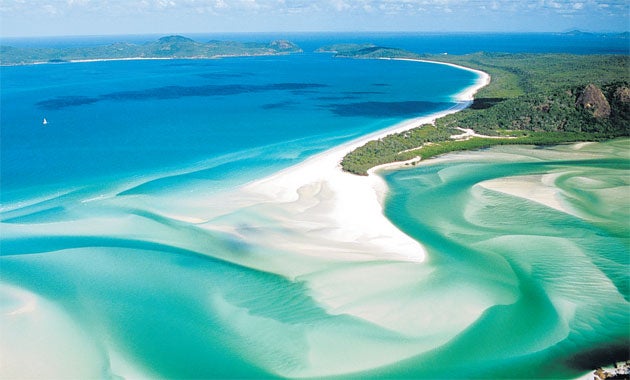At one with the universe in Queensland
Did sand from a beach in the Whitsunday Islands end up in the Hubble telescope?

Splash was holding court on the deck of the Mantaray, a 30-year-old cruiser that, like her skipper, gave off an ageing and rugged charm. Splash was just what I'd imagined the captain of a boat to be like: loud, charismatic and leather-skinned. He finished his speech like this: "And if you look around my boat and see someone you don't know, remember that you're in Australia now and when you don't know someone in Australia you do this." He strode over to a man sat at a table and thrust out a hand. "G'day mate, I'm Splash, how're you going?"
After that, we set sail for the Whitsundays – a collection of more than 70 tropical islands given their name by Captain James Cook when he chanced upon them in May 1770. As Airlie Beach harbour narrowed to a speck behind us, the expanding ocean exposed the three-man crew and 22 paying passengers to a winter's morning in north Queensland: hot sun, cloudless sky.
I'd boarded the Mantaray to secure a first-hand experience of Whitehaven Beach, reputedly one of the best beaches it is possible to come across. Located on Whitsunday Island – the largest in the group – Whitehaven's sands apparently have a silica purity of 98 per cent, which may explain why many locals, Splash included, call it the whitest beach in the world.
Whitehaven is reckoned to hold a second distinction: the smallest sand grains known to man, meaning that the individual particles combine to make the most perfect glass-making material on the planet. Splash told me it was well known in this corner of Queensland that in the 1970s a bunch of Nasa scientists turned up on the island, took a few sack loads of the white stuff back to America with them and used it to make the lens for the Hubble space telescope – a device that has since done more than any other to advance our view of the universe.
After 45 minutes gliding over an ocean as flat as a duck pond, Whitsunday Island appeared as a dot, gradually revealing itself as an irregularly shaped, dark green mound flanked by a narrow strip of cream and turquoise.
Our first trip ashore was not on to Whitehaven but into Tongue Bay, where there was hardly any sand and lots of dead coral – dried, broken and crushed. Splash dropped anchor to allow his passengers access to Hill Inlet Lookout, a man-made viewing platform carved out among the sweaty vegetation of the island's interior. The view was spectacular enough (sea, sky, distant islands – that kind of thing) but having just climbed a steep track in the intense heat, I thought that Whitehaven's sands, located directly below, would be better to lie on than look at.
Half an hour later I got my wish. The Mantaray chugged around the side of the island. I dived off her bow and waded on to the beach through the shallows. The sand was like talc – fine, soft, powdery and yes, also very white. I sat down and scooped some up, squinting up at the heavens as I let it slip through my fingers. Then I stretched out and slept, eventually being woken up by the crew. Time to go back to the mainland.
When I arrived back in Britain, the first thing I did was visit Nasa's website and send an email to an address that had been set up for public enquires. Although I didn't expect to discover a great deal from an organisation that possesses a fair reputation for secrecy, my question about the link between Whitehaven and the Hubble telescope provoked an almost immediate response. I found myself in contact with a man named J D Harrington, an expert on Hubble issues, who promised ~a quick answer.
The next morning, Mr Harrington contacted me to say he was still working on the query but because of the length of time that had elapsed since Hubble was built, it wasn't a simple one. A couple of days later, he emailed me again: "This query has been discussed with dozens of people at the Space Telescope Science Institute, Nasa Goddard, several folks at HQ and many down at Nasa Marshall. No one has been able to confirm or deny this as happening... We're trying to reach one more person, who helped to build Hubble but is retired, so it might be another day or two."
That was the last I heard from Nasa. The one thing I can be certain of is that as long as the sun beats down on to the blistered boards of the Mantaray, Splash will continue to tell his stories. And if Splash says Whitehaven's sands revealed the universe, that's good enough for me.
Travel essentials Queensland
* Paul Duffield visited Queensland as the winner of the "Best Adventure in the World" travel-writing competition, presented by Tourism Queensland, Qantas, Big Earth and The Independent. His prize included flights to Queensland with Qantas (08457 747767; qantas.com) and 10 days Britz Bushcamper 4x4 rental (00 800 200 80 801; britz.com.au).
More information
Subscribe to Independent Premium to bookmark this article
Want to bookmark your favourite articles and stories to read or reference later? Start your Independent Premium subscription today.

Join our commenting forum
Join thought-provoking conversations, follow other Independent readers and see their replies